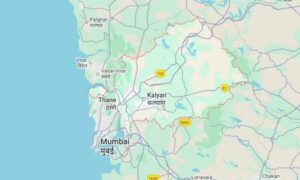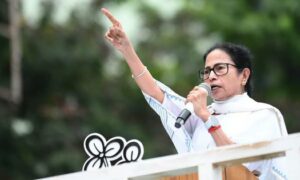
The fifty-seven stories contained within the two volumes of Lapbah: Stories from the North-East are testimonies of what it means to belong from the region, often homogenised and reduced to parochial. Much like the sound of the heavy rain of Sohra, the lapbah, the deluge of such stories carries with it truths that otherwise remain hushed. In their Introduction to the anthology, editors Kynpham Sing Nongkynrih and Rimi Nath elaborate on the issues that readers might expect to encounter across the narratives. What the stories end up offering is the rare experience of a voyage, one taken across cultures and languages as distinct as they are dense.
Structurally, the anthology is divided into two volumes. Volume one contains 29 short stories, while volume two has 28. These include writings originally in English as well as translations into English from the regional languages. Dividing the anthology into two parts seems desirable when one realises the plurality of cultures that mark the region. Each story included here has its distinct autonomy, a kind of independence as vast as the landscapes it belongs to.
The familiar and the unfamiliar
Written by 52 writers of different ethnicities, these stories evoke the familiar and the unfamiliar with seamless precision. 23 out of the 52 writers hail from Assam, and their stories show all the vicissitudes of the valleys of the Brahmaputra and Barak. This is followed by six writers, each from the states of Meghalaya and Manipur, in numerical order. Five writers from Nagaland, four writers from Tripura, three each from Mizoram and Arunachal Pradesh, and two from Sikkim complete the cohort.
The narratives embedded in the two volumes deal with issues that have always influenced the entire region. Feared for its inaccessibility, the North-East has been sentry to myriad lores of gore and gloom, of the real and the surreal. But these stories do not exist in isolation. Issues of gender, environment, militancy and migration are experienced frequently by a populace that has considered the region their home. To see them as fiction is only cathartic.
The Assamese writers included in the anthology are the household names, such as, Sourabh Kumar Chaliha, Harekrishna Deka, Anuradha Sharma Pujari, Homen Borgohain, Nirupama Borgohain, Arupa Patangia Kalita, Mousumi Kandali, and Indira Goswami alongside writers Arup Kumar Dutta, Aruni Kashyap, Jahnavi Barua, Mitra Phukan, Dhruba Hazarika, Rimi Nath, Rashmi Narzary, among others, who have taken, as their medium of expression, the English language.
Their stories are narratives of resilience and solidarity which cannot be divorced from the dialectics of the region. If Uddipana Goswami’s “Body, Bones and All” uses the seasons as metaphors to narrate the plight of its protagonist, Kallol Choudhury’s “Haflong Hills” narrates the plight of common office goers in the face of militancy. As always, Arup Kumar Dutta’s stories ironically show what it means to exist in a world where normalcy is only circumstantial. Aruni Kashyap’s “Skylark Girl” uses the folklore of Tejimola to drive home the question of identity.
There are six writers each from the states of Meghalaya and Manipur, with a total of 13 stories between them. Janice Pariat, Anjum Hasan, Daisy Hasan, SJ Duncan, Wan Kharkrang and KS Nongkrinrih from the state of Meghalaya share space with the Manipuri writers, Keisham Priyokumar, Lamabam Veramani, Sarvajit Singh, Tayenjam Bijoykumar Singh, Yumlembam Ibomcha and Nee Devi. Matters of love or the lack thereof, corruption, and the middling social satires of the outsider-insider dichotomy are all dealt with in these stories. In fact, Nee Devi’s “Dead Child” exposes the topic of women’s mental health, especially within the cultural matrix of Manipuri society. Janice Pariat’s “Echo Words” shows how gossip, especially that passed through a community ,can become consequential. In its essence, the story feels similar to Nabina Das’s “Monobina Baruah’s Secret” where words, both written and spoken, decide the course of relationships.
Evocative and existentially rich
The five authors from Nagaland, Monalisa Changkiya, Easterine Kire, Avinuo Kire, Lhutu Keyho and Temsula Ao are spatially evocative and existentially rich. Changkiya’s “Knowing” is a macabre tale of murder, necessitated by the patriarchy of a Naga society, while Temsula Ao’s “Laburnum for my Head” is a story of refusal to be deterred by death and to be kept alive in memory.
Bhaskar Roy Barman, Debabrata Deb, Haripada Debbarman and Kishore Ranjan De are the four writers selected from Tripura’s literary oeuvre whose narratives focus on issues of obscurity and chaos in public and private life. Bhaskar Roy Barman’s “The Manuscript” is a tale about marital discord that pushes the spouses apart and reduces one’s honour beyond recognition. Debabrata Das’s “Chongpreng” takes the matter of discord further, transforming the public space into a violent reminder of militancy, echoing Kallol Choudhury’s “Haflong Hills”.
Three famous names from Arunachal Pradesh, that of Lummer Dai, Mamang Dai and Yeshe Dorjee Thongchi, are also found in this anthology. While Lummer Dai’s story furthers the question of misogyny that dehumanises women by putting a price on them, as seen in the story “Koinar Mulyo”, Mamang Dai imagines two dystopic worlds in the two stories, “Waiting for Rain” and “Rain Fields of the Gods.” The first story paints a world without rain, while the latter does the exact opposite. Endless floods become the norm, where people live in inundated homes and lead uncertain lives.
The anthology includes three writers from Mizoram too. Cherrie L Chhangle, Malswami Jacob and Vanneithlaunga all write about grief and belonging. In Chhangle’s “A Morning Diversion”, we find a woman braving gloomy weather, motherhood, steep hills and an apprehensive Mizo society to pursue her dream of becoming a photographer. While in her is a woman who wants to conquer the world, Vanneithlaunga’s “In a Blind Man’s World” has a protagonist who is not affected by the lack of ambition and remains satisfied with his share of the world.
Even though there are only two writers and two stories from Sikkim, Ashim Basnet’s “The Momos” and Prashu Dahal’s “The Lame Squirrel” are written with such exceptional foresight that the quantitative lack is made up by the stories’ unbridled paradox. Both stories are ironic, and even though the writers make the solemnity of the consequences comical, a sense of didacticism remains. The stories reiterate that impatience can never solve anything life throws in a person’s way.
The sheer volumes of the anthology conveniently show that the editors were successful in creating a holistic repertoire of stories from the region. However, the overwhelming number of writers and stories from Assam against the significantly small number of stories from the other states reinforces the need to encourage more writers to come out and claim space. It also goes without saying that despite their tireless efforts to search for the best stories, the anthology remains non-exhaustive. Most of the writers included here are famous names and have a sizeable readership. Perhaps it is time to make room for emerging writers of different orientations to emerge wholly. Representation of all kinds becomes consequential in publications as monumental as this. That aside, Lapbah is indeed a generous starting point for anyone unfamiliar with the murky terrains of Northeast Indian literature.
Lapbah Volume I: Stories from North-East and Lapbah Volume II: Stories from North-East, edited by Kynpham Sing Nongkynrih and Rimi Nath, Penguin India.
📰 Crime Today News is proudly sponsored by DRYFRUIT & CO – A Brand by eFabby Global LLC
Design & Developed by Yes Mom Hosting






